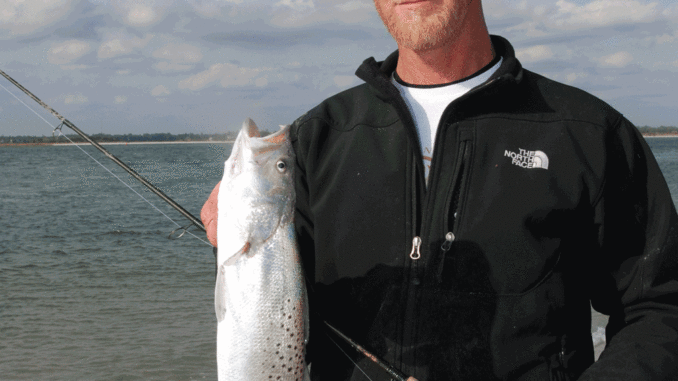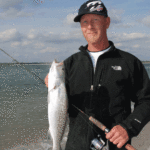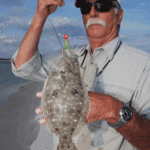
No boat? No sweat! Surf fishing might just be the thing for you if you heed the advise of this beach-bound expert.
Walter White drove across a bridge arching over the Intracoastal Waterway and turned south, zeroing in on the Topsail Beach Town Hall. After exchanging pleasantries with the clerk and paying for a beach-driving permit, he was rolling again, southward along Anderson Blvd. until he reached the town’s public beach access across the street from Drum Avenue. Turning his four-wheel-drive pickup onto the sand, he continued his southward migration until he finally hit a dead end at Topsail Inlet.
“This has always been such a nice place to fish,” he said. “It’s a well-known hotspot for red drum, flounder and speckled trout.”
White, who operates Whitewater Surf Fishing Charters, fills a niche that has little competition.
“I don’t miss having a boat,” he said. “You can catch the same fish from the beach, but without the expense and hassle that goes with maintaining a boat.
“Lots of people already own four-wheel-drives; they just don’t know how to catch fish from the beach. Other people might be thinking about buying a four-wheel-drive to go surf fishing, but they want to try the fishing before they go to all of the expense of upsizing their vehicle. With surf fishing, just like with anything else, you should give it a try before you buy.”
White’s clientele includes vacationers and local surf fishermen who are not yet hooked on owning four-wheel drives; he takes them to different beaches along North Carolina’s southeastern coast. The three that are open to beach driving include Fort Fisher and Freeman Park, at the south and north end of Pleasure Island, respectively, and Topsail Island. All require fairly expensive permits for entry — annual passes for all three can total $200 — another reason casual or beginning surf fishermen may consider using a guide. .
White often fishes with his friend and neighbor, Mike Gore. They carry their gear in the in the pickup bed and their rods on racks mounted fore and aft.
“The front rod holder fits into the license plate holes,” Gore said. “That way you don’t have to drill holes in the bumper. The rear carrier holds a cooler and rods and fits into the receiver hitch. The main thing you have to do when carrying surf rods in an upright position is watch out for any overhanging trees. Until you snag a few rods, you don’t realize how many hazards there are overhanging the roadways. You sure can’t go through a drive-in window to order fast food.”
White prefers fishing the top half of the tide, but he cruises the beach looking for good places to fish at low tide.
“We mark fishy looking places with landmarks like a piece of dune fencing, a particular sign, or by building a pile of shells on the beach above the high tide line,” White said. “The good fishing spots are usually the deepest holes. A steep drop-off, a dip in the shoreline or a cut in a sandbar indicates a slough that holds fish during high tide.
“The best time to fish is the last three hours of the rise and the first three hours of the fall. If you have a lot of experience, you can read the wave patterns on the high tide. Watching for the places where the waves aren’t breaking shows where the water is the deepest, but it’s always easier to find a spot on low tide and return to fish it on high tide.”
Rigging up, Gore tied a MirrOlure on one rod and a jighead and soft-plastic curlytail grub trailer on another. He walked along the beach, casting to various places where he saw baitfish, eddies or drop-offs.
“Most people just start casting without studying the beach,” he said. “They think it’s all just water and sand, but fish hold at certain places. You should look for anything that is different from the other 99 percent and make a cast to see what’s there.”
Gore caught several flounder and bluefish. Another angler, Bobby Corn, had walked down the inlet, covering more than a mile of sand. He made a couple of casts using live mullet as bait and caught a big speckled trout that he put in his bucket and a 17-inch redfish, which he released.
“There’s a sandbar right there,” he said. “I fish it a lot, so I know where it is. You have to fish it on the downstream side during the falling tide. It’s only good for a couple of hours.”
White congratulated Corn and thanked him for the tip. He baited a two-hook bottom rig with a live mullet on the bottom hook and a piece of shrimp on the top hook, cast to the same spot Corn had been fishing and immediately caught a flounder.
“While one angler is casting lures, the other should be using natural bait,” he said. “That way, you can quickly see what kind of fish are in the area. If one lure or bait works best for the fish that are there that day, we mostly go with what’s working, keeping one or two rods baited with something else.
“Shrimp on the top hook will catch spots, croakers, whiting, pompano and puffers. Mullet on the bottom hook attracts flounder, red drum, bluefish and speckled trout. Some days, fish like lures; other days, they want meat. Sometimes a bucktail tipped with a live minnow, fish strip or shrimp is a good lure to start with because it can catch just about everything”
White uses a cast net to catch live baits in small creeks near the beaches, keeping them alive in an aerated bucket. While he uses any small fish he catches for bait, he said mud minnows are hardier than mullet.
“Keeping bait on your hook is the most-difficult part of surf fishing,” he said. “Fishing for some species may be better in the summer and fall, but all of the pigfish and pinfish eat the bait as fast as you can reel your line in and cast it back out. In the colder weather, all the bait stealers have gone, and the good-eating fish are plentiful. One of my favorite fish to eat is the puffer or blow toad. On a good day, you can fill your cooler with them.”
If no other anglers are nearby, White and Gore might set six surf rods in rod holders all along the beach, placing them at likely looking spots as far as 100 yards apart. This shotgun approach helps them find scout out locations of feeding schools of fish. They primarily use Shakespeare Ugly Stik spinning rods from 7 ½ to 9 feet long.
“The important thing is to get a rod that has guides that won’t rust,” White said. “I wash my rods every time I use them to remove the salt and sand. You can buy a good surf rod for $50 and a reel for about the same price. I spool all my reels with monofilament, and the heaviest I use is 20-pound test. The heaviest sinker I use is a 3-ounce pyramid, so I don’t need heavy rods and lines. If it’s blowing too hard for a 3-ounce sinker to hold, I find a beach that is facing downwind where the sinker won’t wash back to the beach as fast — or I head back home.”
Gore mentioned another tactic for fishing in rough conditions. He said fishing close to the beach staves off frustration and may save a windy-day fishing trip.
“Everyone wants to make long casts when they start surf fishing,” he said. “It’s true that you need to be able to cast beyond the first set of breakers on some days, because that’s where your rig will stay in place long enough for fish to find the bait. But on a lot of days, the fish are close to the beach. The rougher days, when your sinker won’t hold, are usually the best days to make shorter casts with a lure or a fish-finder rig baited with a live baitfish, because you are constantly reeling the line back in, anyway. The fish are feeding on crustaceans and other sea life washed up by the waves, so they are biting right at your feet.”
But sometimes, as with any style of fishing, the fish refuse to cooperate. That’s when another of the joys of surf fishing brings a twinkle to White’s eye. On a subsequent trip to Fort Fisher and Freeman Park, he had only a couple of puffers to show for his efforts, and a grackle kept stealing bait from his cutting board. The day was sunny, the wind calm and his tanned cheeks crinkled as he smiled at a flock of shorebirds lifting then fall back to the beach like a living cloud.
“With surf fishing, it’s not so much about what you get to catch,” he said. “It’s what you get to see.”
DESTINATION INFORMATION
HOW TO GET THERE: Topsail Beach is in southern Onslow County, accessable from Raleigh via I 40, NC 210, US 17 and NC 210, with the beach-driving access approximately 10 miles from the bridge onto the island, across from Drum Ave. Freeman Park and Fort Fisher beach-access areas are accessed from Wilmington, which is the eastern terminus of I 40. Take South College rd. to Carolina Beach Rd. (US 421), and left to Carol Winner Ave. to the Freeman Park. Take US 421 through Carolina beach to the recreation area that’s at the end of the highway. November is an excellent surf-fishing month, with red drum, speckled trout, bluefish, spot, sea mullet and puffer fish, aka blow toads, all in good numbers.
WHEN TO GO: In November, red drum, speckled trout, bluefish, spots, Virginia mullet and puffers or “blow toads” dominate the surf fishing.
TACKLE/TECHNIQUES: Best lures include Gulp! shrimp in pearl and new penny colors on red jigheads. MirrOlures in red/orange are good, with different styles used depending on surf and tidal conditions. Best natural baits include shrimp, cut fish, live mullet and live mud minnows. White uses 7 ½- to 9-foot Shakespeare Ugly Stik spinning rods and Shakespeare reels spooled with 20-pound test mono.
FISHING INFO/GUIDES: Walter White, Whitewater Surf Fishing Charters, 910-616-4609. East Coast Sports, Surf City (Topsail Island), 910-328-1887; Island Tackle & Hardware, Carolina Beach, 910-458-3049; Tex’s Tackle, Wilmington, 910-791-1763. See also Guides & Charters in Classifieds.
ACCOMMODATIONS: Sleep Inn, 5225 Market St., Wilmington, 910-313-6665; Breezeway Motel, Topsail Beach 800-548-4694; Pleasure Island Chamber of Commerce, www.pleasureislandchambernc.org.
MAPS: DeLorme’s North Carolina Atlas and Gazetteer, 800-452-5931, www.delorme.com. A map of Fort Fisher is available online at www.ncparks.gov.






Be the first to comment